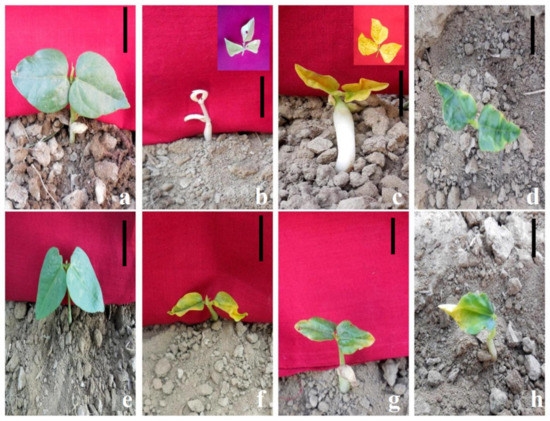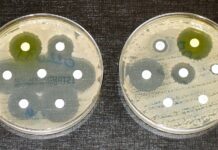Illustrative Image: Evaluating EMS, Sodium Azide, and Hydroxylamine for Inducing Chlorophyll Mutations in Cowpea: Best Strategies for Efficient Mutation Breeding
Image Source & Credit: MDPI
Ownership and Usage Policy
A study by Liamngee et al. (2025) titled “Assessment of the Effectiveness and Efficiency of Ethyl Methane Sulphonate, Sodium Azide and Hydroxylamine Hydrochloride in the Induction of Chlorophyll Mutations in Cowpea (Vigna unguiculata L. Walp)” published in Direct Research Journal of Biology and Biotechnology reveals that Ethyl Methane Sulphonate (EMS) effectively and efficiently induces diverse chlorophyll mutations in cowpea with high frequency and minimal toxicity.
“
Ethyl Methane Sulphonate (EMS) is the most effective and efficient mutagen for inducing diverse, low-toxicity chlorophyll mutations in cowpea.
– Liamngee et al. 2025
This study evaluated the performance of three chemical mutagens—Ethyl Methane Sulphonate (EMS), Sodium Azide (SA), and Hydroxylamine Hydrochloride (HH)—in inducing chlorophyll mutations in cowpea, focusing on their effectiveness (ability to induce mutations) and efficiency (ability to induce mutations with minimal harmful effects). Cowpea is a crucial legume in West Africa, particularly Nigeria, valued for its nutritional content and drought tolerance. Chlorophyll mutations, such as albino, chlorina, and maculata types, manifest as visible changes in leaf coloration. While these mutations do not directly improve agronomic traits, they serve as early indicators of genetic alterations that may lead to desirable characteristics like increased yield, pest resistance, or drought tolerance.
Among the mutagens tested, EMS induced the highest number of chlorophyll mutations and demonstrated the best efficiency, particularly at a 0.1% dose, combining high mutation rates with relatively low toxicity. Sodium Azide (SA) showed the greatest effectiveness at its lowest dose (0.01%), indicating a strong ability to induce mutations, but its higher toxicity reduced overall efficiency. Hydroxylamine Hydrochloride (HH) was the least effective and efficient under the conditions tested. The genotype FUAMPEA 1 was the most responsive, exhibiting the highest mutation frequency across treatments. EMS is recommended for mutation breeding in cowpea due to its optimal balance of high mutation induction and low harmful effects. SA may be applied when high mutation rates are desired, but its efficiency is limited by greater mortality. HH, in contrast, is less suitable for generating beneficial mutations in cowpea under these experimental conditions.
How the Study was Conducted
The study was conducted at the Teaching and Research Farm of the Federal University of Agriculture, Makurdi, Nigeria, with fieldwork carried out between August and November 2022.
Cowpea Genotypes Used
Three cowpea genotypes were selected based on their genetic diversity and agronomic traits:
- FUAMPEA 1 – High-yielding, resistant to Striga and Electra.
- IFE BROWN – Brown-seeded, short cooking time.
- SAMPEA 14 – High-yielding, also resistant to Striga and Electra.
Mutagen Treatments
Three chemical mutagens were applied at three concentrations each (0.01%, 0.05%, 0.1%):
- Ethyl Methane Sulphonate (EMS)
- Sodium Azide (SA)
- Hydroxylamine Hydrochloride (HH)
Seed Treatment Procedure
Seeds were pre-soaked in distilled water for 3 hours, then treated in mutagen solutions stabilized with phosphate buffer for an additional 3 hours. Solutions were stirred every 15 minutes to ensure uniform exposure. After treatment, seeds were thoroughly washed under running water for 1 hour, air-dried, and immediately planted in the field.
Field Layout and Planting
A 3 × 3 × 4 factorial design (genotype × mutagen × dose) was implemented, resulting in 36 treatment combinations. The experiment followed a Randomized Complete Block Design (RCBD) with three replications. Each plot measured 3 m × 1 m, with adequate spacing to prevent cross-contamination between treatments.
Agronomic Practices
- Fertilization: NPK 15:15:15 at 100 kg/ha
- Weeding: Manual, performed at 2 and 5–6 weeks after planting
- Pest Control: Lambda-cyhalothrin for bugs and caterpillars, imidacloprid for aphids
Data Collection and Analysis
Data were recorded from the second mutant generation (M2) and included:
- Chlorophyll mutation types (e.g., maculata, chlorina, semi-albina)
- Mutation frequency
- Mortality rate
Calculations:
- Mutagen Effectiveness: Mutation frequency ÷ (Concentration × Exposure time)
- Mutagen Efficiency: Mutation frequency ÷ Mortality rate
What the Authors Found
A total of 66 chlorophyll mutations were observed in the second mutant generation (M2), comprising maculata (yellow/white leaf spots), chlorina (light green leaves), semi-albina (white leaves with faint green), viridis (small light-yellow green leaves), and xantha (bright yellow leaves). Among the mutagens tested, Ethyl Methane Sulphonate (EMS) induced the highest number of mutations (31 mutations) and demonstrated the greatest efficiency (0.64), particularly at the 0.1% dose, while producing a broad spectrum of mutation types with minimal mortality. Sodium Azide (SA) showed the highest effectiveness at the lowest dose (0.01%), inducing mutations readily, but its overall efficiency was lower due to higher toxicity. Hydroxylamine Hydrochloride (HH) was the least effective and efficient, with mutation frequency generally decreasing at higher doses, except in the SAMPEA 14 genotype.
Regarding genotype response, FUAMPEA 1 was the most responsive across all mutagens, SAMPEA 14 showed better response to HH, and IFE BROWN exhibited moderate mutation frequencies. Overall, EMS emerges as the most suitable mutagen for cowpea mutation breeding due to its high mutation yield and low toxicity. SA may be employed when high mutation rates are desired, though with caution, while HH is less promising under the tested conditions.
Why is this important
Enhancing Food Security: Cowpea, a staple in West Africa, is nutrient-rich; improving yields and pest resistance through mutation breeding supports livelihoods and food availability.
Optimizing Mutation Breeding: Comparing EMS, SA, and HH identifies the most effective and efficient mutagen and dose for inducing beneficial genetic changes.
Tracking Genetic Variability: Chlorophyll mutations act as early indicators of genetic changes, helping identify plants with desirable traits like drought tolerance or disease resistance.
Cost-Effective Crop Improvement: Chemical mutation breeding is faster and cheaper than traditional breeding or genetic engineering, offering non-GMO crop enhancement.
Advancing Scientific Knowledge: The study provides comparative data on mutagen responses across cowpea genotypes, guiding future breeding strategies and research.
What the Authors Recommended
- The authors advocate that Ethyl Methane Sulphonate (EMS) is the most efficient mutagen, producing a broad spectrum of chlorophyll mutations with minimal harmful effects, making it ideal for breeding programs.
- Sodium Azide (SA) is highly effective at low doses but less efficient due to higher mortality; it should be used selectively when high mutation rates are required.
- In addition, authors emphasize that Hydroxylamine Hydrochloride (HH) is the least effective and not recommended for routine breeding. Genotypic response matters—FUAMPEA 1 is particularly responsive and suitable for mutation breeding.
In conclusion, this study demonstrates that Ethyl Methane Sulphonate (EMS) is the most effective and efficient chemical mutagen for inducing diverse chlorophyll mutations in cowpea, offering a reliable and low-toxicity approach for mutation breeding. While Sodium Azide (SA) can induce high mutation rates at low doses, its higher toxicity limits overall efficiency, and Hydroxylamine Hydrochloride (HH) proves least suitable under the tested conditions. The findings also highlight the importance of genotype selection, with FUAMPEA 1 showing the highest responsiveness. By identifying optimal mutagens and doses, this research provides valuable guidance for accelerating cowpea improvement programs, enhancing genetic variability, and supporting sustainable crop production and food security in West Africa.
















 The African Research (AR) Index is a comprehensive scholarly directory and database focused explicitly on journal publishers that publish and disseminate African research.
The African Research (AR) Index is a comprehensive scholarly directory and database focused explicitly on journal publishers that publish and disseminate African research.

